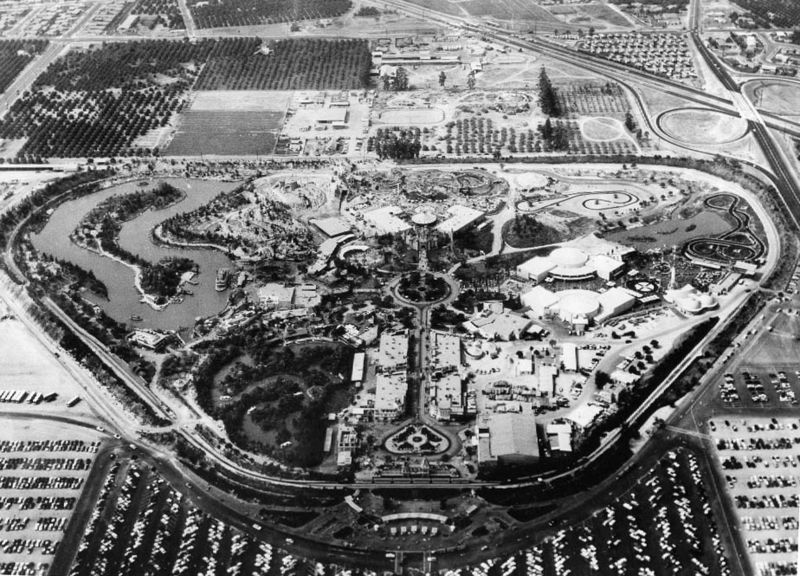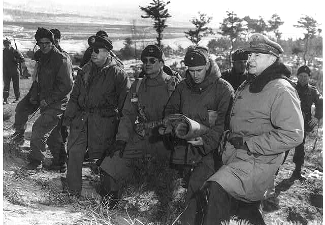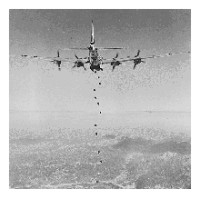
Photo above: One trooper represented in the Korean War Memorial, Washington, D.C., Carol Highsmith Archives, Library of Congress.
Korean War
A remnant from World War II when the Soviet Union, in 1945, wrested control of the Korean peninsula from Japanese control north of the 38th parallel with the United States in the south. By 1948, with Cold War tensions rampant, the peninsula was separated into two halves, North and South, with separate governments that considered the whole as part of their territory. On June 25, 1950, North Korea invaded South Korea, prompting the United Nations to declare the invasion and the United States, with their allies, into conflict against the North, China, and the Soviet Union. The conflict would last for three years. The problem of a divided Korean peninsula still exists today.
Sponsor this page for $100 per year. Your banner or text ad can fill the space above.
Click here to Sponsor the page and how to reserve your ad.
-
Battle Timeline
Korean War - Quick Battle Timeline 1950

Leading to the Invasion, January to June 1950
The division of the Korean peninsula in 1945, using the 38th parallel as suggested by the United States, was never satisfactory to either the Korean people or either subsequent government. It had been an arbitrary dividing line brought on by necessity and a bit of hubris by United States Colonel Dean Rusk, who did not think, when proposed, that the Soviets would agree to a line that far north. They did. But when the Moscow Conference and U.S. Soviet Joint Commission in December 1945 agreed that independence to Korea would only come after a five year trusteeship, riots broke out, followed by strikes. Elections were called in 1948, still under the trusteeship, resulting in two different elected governments, one in the northern zone controlled by the Soviet Union; the other in the South controlled by the United States. Riots and uprisings continued, but the Soviet Union kept their word, leaving the North in 1948. The United States left the South in 1949. While the Korean peninsula continued to have its challenges, the Chinese Civil War between the nationalists and communists raged. North Korea supported the Communists. When they won, they agreed to support the North if they invaded South Korea. Meanwhile, Stalin, after the U.S. had fully withdrawn, started to support North Korea again, thinking that the United States did not consider South Korea as having strategic importance.
The situation in the early months of 1950 saw North Korea, backed by China and the Soviet Union, and armed with heavy weapons by the Soviets, given permission by Stalin to invade, knowing that the United States had left the south with no heavy weapons. By May, a plan to attack was formulated. They would start a skirmish in Ongjin Peninsula, then encircle Seoul. When a peace overture was rejected on June 11, North Korea changed its plan for a general attack across the 38th parallel. It would occur on June 25, 1950. On that same day, the United Nations Security Council issued Resolution 82, condemning the invasion by the North. The Soviet Union had been boycotting the council since the beginning of the year in protest over the seating of Taiwan, not Beijing. The United States declared a "police action" two days later with Truman sending troops.
July 5, 1950 - Battle of Osan
Troops: USA 540; North Korea 5,000.
Casualties (Killed/Wounded/Missing): USA 81 plus 82 captured; North Korea 127.
Task Force Smith sent by U.S. south of Seoul to fight rear guard action to delay North Korean troops until additional forces could arrive. North Korean victory eventually overwhelmed position and forced the U.S. task force to retreat.
July 14-21, 1950 - Battle of Taejon
Troops: USA/South Korea 11,400; North Korea 13,500 to 17,600.
Casualties (Killed/Wounded/Missing): USA/Allies 3,500; North Korea NA.
North Korean soldiers attack the 24th Artillery Division headquarters at the tranport hub of Taejon. U.S. held a line at the Kum River, then fought a pitched battle through the city for three days. American forces withdrew, giving North Korea a tactical victory. U.S. delay of North Korea from moving toward Pusan, however, achieved a strategic advantage in the subsequent battle.
August 4 - September 18, 1950 - Battle of Pusan Perimeter
Troops: USA/South Korea/British Commonwealth Nations/Netherlands 141,808; North Korea 87,000.
Casualties (Killed/Wounded/Missing): USA/Allies 60,504 total casualties; North Korea 63,590.
United Nations troops defend a perimeter around the city of Pusan in the southeast after defeats pushed them south. Six weeks of North Korean attacks are repulsed, and with supplies and men dwindling due to heavy losses, they retreat. Battle was the furthest North Korea advanced during the entire war.
September 15-19, 1950 - Battle of Inchon
Troops: USA/South Korea/UK/Canada/France 40,000; North Korea 6,500.
Casualties (Killed/Wounded/Missing): USA/Allies 1,033; North Korea 1,350.
Surprise amphibious invasion led by General MacArther one hundred miles behind enemy lines leads to United Nations victory, a brilliant success allowing for the attempt to retake Seoul.
September 22-25, 1950 - Second Battle of Seoul
Troops: USA/South Korea/UK/Thailand 40,000; North Korea 7,000.
Casualties (Killed/Wounded/Missing): USA/Allies 1,996; North Korea NA.
Slow and difficult progress from Inchon leads to house to house fighting in the heavily fortified city. Decisive United Nations victory liberates the South Korean capital after three months of capture.
October 25-29, 1950 - Battle of Onjong, North Korea
Troops: South Korea NA; China NA.
Casualties (Killed/Wounded/Missing): South Korea NA; China NA.
One of the first major battles in the First Phase Campaign after China entered the Korea War, prompted by South Korean and United Nations troops crossing the 38th parallel north. Decisive China victory destroyed South Korean forces as an effective force and exposed the United Nations forces to attack.
October 25 - November 1, 1950 - Battle of Unsun, North Korea
Troops: USA/South Korea 2 divisions; China 2 corps.
Casualties (Killed/Wounded/Missing): USA/South Korea 1,679; China 600 plus.
Accidental first encounter between USA and China troops in the Korean War leads to one of the most devastating losses by the United States in the war.
November 25 - December 2, 1950 - Battle of the Ch'ongch'on River
Troops: USA/South Korea/UK/Turkey 254,571; China 230,000.
Casualties (Killed/Wounded/Missing): USA/Allies 11-23,000; China 20-40,000, including non-battle casualties.
General MacArthur's campaign to evict China from North Korea after their successful First Phase Campaign. A surprise counteroffensive by Chinese forces eventually forces United Nations forces to evacuate North Korea back to the 38th parallel, allowing China and North Korea to take back full control of North Korean territory in the decisive victory. U.N. would propose a ceasefire to China on December 11. China disagreed.
November 27 - December 13, 1950 - Battle of Chosin Reservoir
Troops: USA/South Korea/UK 103,520; China 150,000.
Casualties (Killed/Wounded/Missing): USA/Allies 17,843; China 48,156, including non-battle casualties. Some estimate indicate a total above 60,000.
Chinese surprise attack leads to pyrrhic victory and withdrawal of United Nations forces from Northeast Korea, but comes with heavy casualties, which reduced capacity to fight for six months. Chinese troops also were not able encircle to United Nations troops around the reservoir, thus allowing their withdrawal.
December 31, 1950 - January 7, 1951 - Third Battle of Seoul
Troops: USA/UK/Canada 148,794 plus unknown number of South Korean troops; North Korea/China 170,000.
Casualties (Killed/Wounded/Missing): USA/Allies 790; North Korea/China 8,500.
Chinese army attacks the 38th parallel, breaching United Nations troops positions, and causes them to evacuate. Chinese take control of Seoul, although their victory and decision mobilizes U.N. initiative and becomes strategic failure.
Full Text, 82nd Resolution of the United Nations, Complaint of Agression Toward the Republic of Korea
82 (1950). Resolution of 25 June 1950
The Security Council,
Recalling the finding of the General Assembly in its resolution 293 (IV) of 21 October 1949 that the Government of the Republic of Korea is a lawfully established government having effective control and jurisdiction over that Part of Korea where the United Nations Temporary Commission on Korea was able to observe and consult and in which the great majority of the people of Korea reside; that this Government is based on elections which were a valid expression of the free will of the electorate of that part of Korea and which were observed by the Temporary Commission, and that this is the only such Government in Korea,
Mindful of the concern expressed by the General Assembly in its resolutions 195 (III) of 12 December 1948 and 293 (IV) of 21 October 1949 about the consequences which might follow unless Member States refrained from acts derogatory to the results sought to be achieved by the United Nations in bringing about the complete independence and unity of Korea; and the concern expressed that the situation described by the United Nations Commission on Korea in its report[1] menaces the safety and well-being of the Republic of Korea and of the people of Korea and might lead to open military conflict there,
Noting with grave concern the armed attack on the Republic of Korea by forces from North Korea,
Determines that this action constitutes a breach of the peace; and
I - Calls for the immediate cessation of hostilities; Calls upon the authorities in North Korea to withdraw forthwith their armed forces to the 38th parallel;
II - Requests the United Nations Commission on Korea:
(a) To communicate its fully considered recommendations on the situation with the least possible delay;
(b) To observe the withdrawal of North Korean forces to the 38th parallel;
(c) To keep the Security Council informed on the execution of this resolution:
III - Calls upon all Member States to render every assistance to the United Nations in the execution of this resolution and. to refrain from giving assistance to the North Korean authorities.
Adopted at the 473rd meeting by 9 votes to none, with 1 abstention (Yugoslavia).
Photo above: Howitzer with United States gun crew near Kum River, July 15, 1950. Courtesy U.S. Signal Corps via Wikipedia Commons. Data source, including casualty amounts: Refworld.org; Official Records of the Security Council; Wikipedia Commons.
History
Photo Bomb






